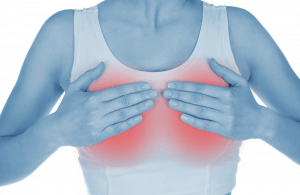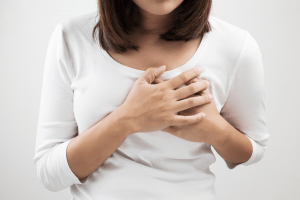Breast pain during menopause refers to the discomfort and pain which women may experience throughout the different menopausal stages. Peri-menopause—the stage preceding menopause, in which periods become irregular—often causes breast tenderness and pain.
Problems with breast tenderness can continue on into menopause, which is defined as the point at which you have not had a period for 12 months. Most women—more than two-thirds—will experience breast discomfort at different times throughout their lives, a symptom typically linked to fluctuating hormones.
This article provides’ you comprehensive information you might need for understanding breast pain during menopause, including the symptoms and possible treatments. Being better educated about breast pain can help you understand the causes of breast tenderness in menopause, coping with symptoms of breast pain, and alleviating this uncomfortable symptom.

Breast pain can be unilateral or bilateral, and may have various hormonal and lifestyle causes.
What is Breast Pain and What are the Causes?
The clinical term for this kind of breast pain is mastalgia, a cyclic or non-cyclical condition that frequently results from hormonal changes or a hormonal imbalance. Mastalgia is a common complaint which will affect up to 70% of women during their lifetime, and presents differently across individuals.
Pain may present bilaterally, or only in one breast, or part of one breast, and it can also radiate through to the armpit and down the inside of the arm. Typically, the affected breast is very tender to touch, and there may be accompanying swelling.
Some possible causes of mastalgia include:
- Psychological factors, such as anxiety and depression.
- Insufficient breast tissue support (unsupportive or ill-fitting bras).
- Hormone replacement therapy—depending on dosage and type, HRT can influence the likelihood of breast tenderness in menopause.
- Caffeine.
- Stress.
- Smoking.
Increased oestrogen, decreased progesterone, and changes in the body’s oestrogen/progesterone ratio have varying effects on your body but have all been identified as possibly playing a role in breast soreness in menopause.
General Symptoms of Breast Pain during Menopause
Symptoms of breast pain will vary depending on the individual woman. Pain and discomfort may be constant or intermittent, and pain levels may vary day to day. Some general symptoms of breast pain include:
- Soreness
- Burning
- Discomfort or pain in one or both breasts
- Breasts too tender to touch, leading to the inability to tolerate a bra or even light clothing due to discomfort
- Sharp, stabbing or throbbing pains
It is important to be aware that your breast soreness may not always be linked to perimenopause. Consult your doctor if any of these additional symptoms arise:
- Pus discharge from the nipple in a clear, yellow or bloody fluid
- Noticeable increase in breast size
- Redness
- Fever or chest pain
The addition of these symptoms could be an indication that a more serious condition exists. Always consult a doctor to confirm if breast soreness is hormonal or caused by another condition.
Are you experiencing this symptom?
Take the questionnaire to determine if it may be a sign of menopause, and discover how we can help
Breast Pain Menopause Treatment

Breast pain can have a serious impact on the sufferer’s day-to-day life.
Luckily, there are a range of available remedies which can help address menopausal breast pain. Over-the-counter (OTC) pain medications such as Panadol can relieve pain or discomfort, while other options are designed to treat hormonal causes, such as hormone replacement therapy (HRT). HRT will require consultation with a doctor to determine the best option for you and a prescription for the treatment.
Other remedies for breast pain include changing dietary and lifestyle habits to reduce the likelihood of breast tenderness and minimise symptoms. Other methods of addressing menopausal breast pain include:
- Drinking more water. Mild dehydration can cause fluid retention, which may worsen breast pain. Drink more water or eat fruits that can help keep you hydrated.
- Reduce or stop smoking. Since studies have shown a relationship between smoking and breast pain, minimising or quitting smoking can help reduce discomfort over time.
- Wear supportive, well-fitted bras. Supporting breast tissue minimises trauma to the tissue and can help reduce pain.
- Avoid or minimise caffeine. Studies have also drawn causal links between regular caffeine consumption and breast pain, so reducing your caffeine intake may provide a way of treating breast pain.
- Apply a warm compress or take a hot shower. Heat can often act to reduce breast soreness.
The Different Types of Breast Pain
There are three different types of breast pain that you may experience, each with varying symptoms and effects. The cycles can be identified as follows:
Cyclical
This kind of breast pain is hormonal and can be determined by:
- A link to the timing of your menstrual cycle
- Dull, heavy or aching pain
- Similar pain in both breasts
- A gradual increase in the amount of pain in the lead up to your period
- Commonly found in pre-menopausal and perimenopausal stages
Non-Cyclical
This type of breast pain is non-hormonal and can be determined by:
- General soreness, tightening of the breast or burning sensations
- The pain can be either sporadic or consistent
- The pain will often be in a particular area of the breast
- Usually experienced by post-menopausal women
Extramammary
Often referred to as the “chest wall,” this pain is found around the breast area as opposed to the actual breasts themselves
- Sometimes caused by injuries to the ribs
- The result of torn muscles in the shoulders or chest
- Inflammation in the costal cartilage
Costochondritis
Further to extramammary pain, costochondritis can begin in the rib region, spreading then to the breasts. The inflammation of the costal cartilages can be related to a various number of issues including injury to the chest, excessive strain or forceful coughing, and related injuries.
If the pain worsens or significantly restricts your every day, you should consult your GP immediately.
The Australian Menopause Centre Can Help
If you are experiencing any of the above symptoms, please do not hesitate to contact us on 1300 883 405 to book a free no obligation first consultation and discuss your concerns with one of our doctors.
Book A Free No Obligation Medical Consultation
Speak with one of our doctors confidentially to discuss & if you are suitable a treatment plan will be prescribed.